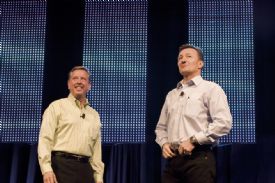 Flyt för Aras PLM: - De senaste årens vinnare när det gäller nya användare
Flyt för Aras PLM: - De senaste årens vinnare när det gäller nya användare
 Flyt för Aras PLM: - De senaste årens vinnare när det gäller nya användare
Flyt för Aras PLM: - De senaste årens vinnare när det gäller nya användare
 ”Great ERP, worse PLM” – What SAP PLM needs to sharpen its competitive edge
”Great ERP, worse PLM” – What SAP PLM needs to sharpen its competitive edge
 PLM Spending: A period of “Digestion” after two years of explosive growth
PLM Spending: A period of “Digestion” after two years of explosive growth
 The Market for PLM Services: Why Accenture thinks they can rattle IBM
The Market for PLM Services: Why Accenture thinks they can rattle IBM
 TV-report: The Internet of Things – The secret to what PLM and ERP can do in the smart revolution
TV-report: The Internet of Things – The secret to what PLM and ERP can do in the smart revolution
 Not ”a load of crap” anymore: ”PLM 360 is way ahead of plan”, says Autodesk’s Carl Bass
Not ”a load of crap” anymore: ”PLM 360 is way ahead of plan”, says Autodesk’s Carl Bass
 "Demolish the silos in PLM": Why Dassaults Bernard Charles believes in the 3D Experience
"Demolish the silos in PLM": Why Dassaults Bernard Charles believes in the 3D Experience
 The Next Big Boom in PLM and ERP and the Battle Over mBOM Ownership
The Next Big Boom in PLM and ERP and the Battle Over mBOM Ownership
 From the graveyard of ERP to the world’s largest start-up: Infor TV Report
From the graveyard of ERP to the world’s largest start-up: Infor TV Report
 What Happened to Volvo engineering and PLM under Chinese ownership?
What Happened to Volvo engineering and PLM under Chinese ownership?
 Will GE and PTC’s joint venture create a ”PLM and manufacturing advantage”?
Will GE and PTC’s joint venture create a ”PLM and manufacturing advantage”?
 Inside Daimler Mercedes Switch from Dassault Systèmes to Siemens PLM and NX
Inside Daimler Mercedes Switch from Dassault Systèmes to Siemens PLM and NX
 Truck Maker’s PLM Model a Focus in Volkswagen’s War Over Ownership
Truck Maker’s PLM Model a Focus in Volkswagen’s War Over Ownership
 The Role of 3D Printing in Manufacturing and PLM – TV Report
The Role of 3D Printing in Manufacturing and PLM – TV Report
 The Third Platform – A Quantum Leap for PLM and ERP
The Third Platform – A Quantum Leap for PLM and ERP
 SolidWorks Mechanical Conceptual: Late and Great, but too Expensive? – TV Report
SolidWorks Mechanical Conceptual: Late and Great, but too Expensive? – TV Report
 Big Data – Big Problem? – TV Report
Big Data – Big Problem? – TV Report
 Applauds to the European Parliament’s call to modernise EU public works projects with BIM technology
Applauds to the European Parliament’s call to modernise EU public works projects with BIM technology
 Siemens, Tesis PLMware and Industry 4.0
Siemens, Tesis PLMware and Industry 4.0
 Why PTC acquired ThingWorx and how M2M will change everything
Why PTC acquired ThingWorx and how M2M will change everything
 Autodesk’s CEO, Carl Bass: We want to change the way people work – TV Report
Autodesk’s CEO, Carl Bass: We want to change the way people work – TV Report
 How MOBILITY transforms Product Development, Manufacturing and Service – TV Report
How MOBILITY transforms Product Development, Manufacturing and Service – TV Report
 Can PLM Systems Manage Highly Complex Products? – TV Report
Can PLM Systems Manage Highly Complex Products? – TV Report
 Dassault’s 3DEXPERIENCE Platform – TV Report
Dassault’s 3DEXPERIENCE Platform – TV Report
 PLM Systems Cleared for Take Off at Airbus
PLM Systems Cleared for Take Off at Airbus
 FRONTRUNNERS Takes a Look Inside Volvo’s Construction Equipment
FRONTRUNNERS Takes a Look Inside Volvo’s Construction Equipment
 Battle of the Visions part 3: PTC breaks new ground in the PLM landscape - claims CEO Jim Heppelmann
Battle of the Visions part 3: PTC breaks new ground in the PLM landscape - claims CEO Jim Heppelmann
 User experience the deciding factor when Dutch shipbuilder, Damen, chose IFS
User experience the deciding factor when Dutch shipbuilder, Damen, chose IFS
 PTC’s Windchill 10.0 – will 100 million in R&D take PLM to the next level?
PTC’s Windchill 10.0 – will 100 million in R&D take PLM to the next level?
 The French Connection ...more possibilities than problems, when SolidWorks is “dassaultified”?
The French Connection ...more possibilities than problems, when SolidWorks is “dassaultified”?
 Management swap at SolidWorks - Jeff Ray Steps down as CEO, Bertrand Sicot takes over
Management swap at SolidWorks - Jeff Ray Steps down as CEO, Bertrand Sicot takes over
 SolidWorks’ Jeff Ray confirms in an interview transition to Dassault’s V6 platform
SolidWorks’ Jeff Ray confirms in an interview transition to Dassault’s V6 platform
 13/12/2010
CAD
13/12/2010
CAD
 VERKSTADSFORUM.SE:S TELEGRAMREDAKTION
VERKSTADSFORUM.SE:S TELEGRAMREDAKTION
SolidWorks’ Jeff Ray confirms in an
interview transition to Dassault’s V6 platform

Bildtext: SolidWorks CEO, Jeff Ray, (left) Dassault Systemes CEO, Bernard Charles (right).
Jeff Ray, the CEO of SolidWorks, confirmed in an interview, with VerkstadsForum’s Verdi Ogewell, that the company will be moving their CAD solution to Dassault Systemes’ V6 platform. Today the program is driven with Parasolids kernel technology, and has been since the start, in 1995. A platform which will remain in use as long as the users want it to, but the next generation of SolidWorks 3D CAx solutions will be based on the Dassault V6 platform and the CGM core technology, which also is, in fact, what Dassault’s CAD flagship, Catia, uses.
- They can remain in the SWx environment (x stands for the version number you might be using i.e. SW 2010) that they already have. “We have a great relationship with Parasolid, and that will continue for a long, long time.”
- Or they can move to the new V6-based platform whenever they choose to do so.


















